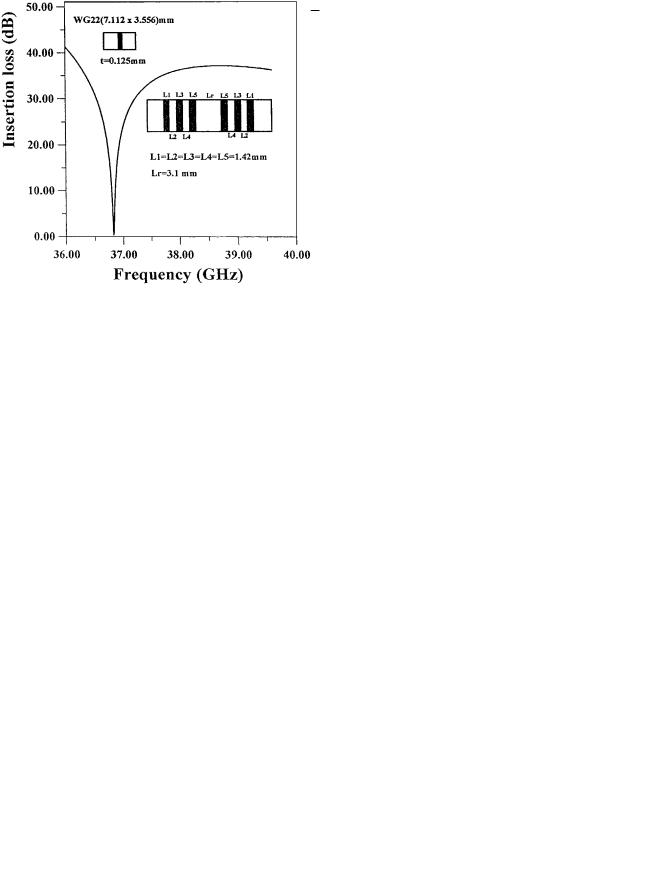

NOVEL HIGH-Q WAVEGUIDE E-PLANE RESONATORS USING PERIODIC METALLIC SEPTA
Djuradj Budimir1 and Charles W. Turner 2
1Laboratory for Wireless Communications Department of Electronic Systems University of Westminster
London W1M 8JS, England
2Department of Electronic Engineering King’s College
University of London London, England
Recei¨ed 22 June 1999
Key words: microwa¨e resonators; wa¨eguide resonators; periodic structures
ABSTRACT: A no¨el class of wa¨eguide E-plane resonator structures using periodic metal septa for use at millimeter-wa¨e, submillimeter-wa¨e, and terahertz frequencies has been proposed. It aims to show that this type of resonator can be easily realized with a single metal insert within a rectangular wa¨eguide. One type of resonator which used quarter-wa¨e- length metallic septa was employed. The simulated results for an air-filled metal pipe rectangular wa¨eguide resonator using periodic metallic septa at 37.80 GHz is presented. The measured frequency response of a rectangular wa¨eguide E-plane resonator shows 30 dB rejection at 36 GHz. Q 1999 John Wiley & Sons, Inc. Microwave Opt Technol Lett 23: 311]312, 1999
I. INTRODUCTION
The steady growth in commercial interest in millimeter-wave, submillimeter-wave, and terahertz systems, especially in wireless communications, security, and sensor applications and military and transportation electronics, has provided a significant challenge to conventional microwave circuits and their design methodologies. High-performance narrowband bandpass filters having both a low insertion loss and a high selectivity are important for modern millimeter-wave communication systems. At present, most filters at millimeter-wave frequencies are produced either in a waveguide air-filled metal pipe, dielectric filled, or micromachined air filled. with high associated machining costs, image guide, and nonradiative dielectric guide with high associated loss w1]4x. or using planar technologies microstrip, suspended substrate strip line, and coplanar waveguide. w5]9x. Suspended substrate technologies become expensive due to the many via holes needed for grounding and shielding. Generally, microstrip and coplanar waveguide filters are not able to achieve highselectivity characteristics because the Q-values are limited by loss and radiation. Although, in principle, highly selective characteristics can be achieved by using elliptic function filters, this technique becomes less viable at millimeter-wave frequencies.
Recently, we have investigated a novel class of waveguide resonators with clear advantages for use at millimeter-wave, submillimeter-wave, and terahertz frequencies. One particular type of structure, the resonator with periodic metallic septa, has been developed in our laboratories. Figure 1 shows the schematic form of a waveguide E-plane resonator which used quarter-wavelength metallic septa. The elements in the first and third components can be, for example, one-quarter wavelength long, and the second component can be one-half wavelength long, the wavelength being measured at the cen-
Figure 1 Configuration of rectangular waveguide E-plane resonators
tral operating frequency of the resonators. Alternatively, the lengths of the first and third components could be submultiples of a quarter-wavelength long, such as 1r8 or 1r16 of a wavelength, etc.
This kind of structure is expected to find application, particularly, in low-phase-noise millimeter-wave, submillime- ter-wave, and terahertz oscillators, highly selective millime- ter-wave, submillimeter-wave, and terahertz filters, diplexers and multiplexers, quasioptical narrowband bandpass and notch filters, frequency-selective surfaces, and antennas.
II. NUMERICAL AND EXPERIMENTAL RESULTS
The simulated insertion loss of the waveguide E-plane resonator using periodic metallic septa at 36.80 GHz is shown in Figure 2. The dimensions of the E-plane insert are given in the same figure. Mode matching with 100 modes was used for electromagnetic simulation of the behavior of the waveguide discontinuities throughout the design EPFILT. w10x. Figure 3 shows the measured transmission loss of the fabricated waveguide resonator at 36.8 GHz. The designed resonator was fabricated using brass for the waveguide housing and copper for the metal insert. The measurement was made using an HP 8510B vector network analyzer. A photograph of the waveguide E-plane resonantor is shown in Figure 4.
III. CONCLUSION
A novel class of waveguide high-Q resonator structures using periodic metallic septa for millimeter-wave, submillimeterwave, and terahertz applications has been proposed. They can
Figure 2 Shape of the waveguide E-plane resonator with periodic metal septa and simulated insertion loss of waveguide E-plane resonator at 36.80 GHz
MICROWAVE AND OPTICAL TECHNOLOGY LETTERS / Vol. 23, No. 5, December 5 1999 |
311 |
